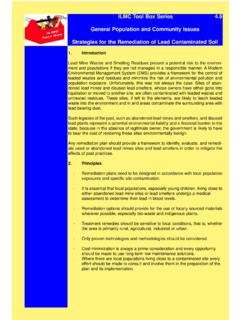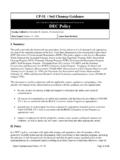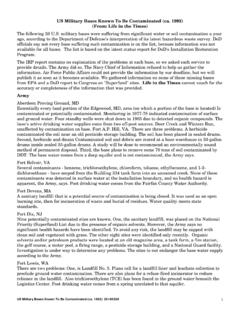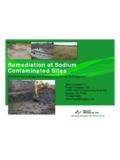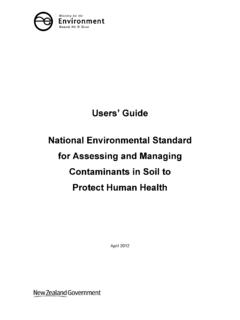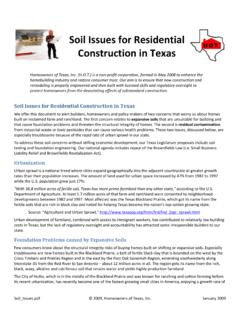Transcription of Definitions for List of Contaminated Sites
1 Key to Site Definitions for List of Contaminated or Potentially Contaminated Sites ("Hazardous Waste Facilities" as defined by CGS section 22a-134f). The following is a key to the terms used in the Site Definition field on the List of Contaminated or Potentially Contaminated Sites : CERCLIS. CERCLIS Sites are potential hazardous waste Sites in Connecticut that the EPA is evaluating under the Comprehensive Environmental Response, Compensation and Liability Act (CERCLA), also known as Superfund. These Sites are included in EPA's CERCLIS database. This database, the Comprehensive Environmental Response, Compensation and Liability Information System (CERCLIS), is the national database and management system EPA. uses to track activities at hazardous waste Sites considered for cleanup. CERCLIS contains information on hazardous waste Sites , potential hazardous waste Sites , and remedial activities across the nation, including Sites that are on the National Priorities List (NPL) or being considered for the NPL.
2 There are 16 Sites in Connecticut on the NPL, and 2. Sites have been deleted from the NPL. These Sites are also included in CERCLIS, and additional information about the NPL Sites is available at A description of how Sites are listed on the NPL is at Please note that the list does not include Sites that EPA has evaluated and has determined that no further remedial actions are necessary. HAZ WASTE LAND DISPOSAL NOTIFIERS. Hazardous Waste Land Disposal Notifiers (also known as RCRA Land Disposal Facilities or LDFs), are facilities that notified EPA that they disposed of hazardous waste to the ground pursuant to the Resource Conservation and Recovery Act of 1976 ("RCRA") which is at 42 USC 6901, et. seq. More information about RCRA LDFs is available at INVENTORY OF HAZARDOUS WASTE DISPOSAL Sites . These are Sites which may pose a threat to the environment or public health and are listed on the Inventory of Hazardous Waste Disposal Sites ("the Inventory"), pursuant to section 22a-133c of the Connecticut General Statutes (CGS).
3 LEAKING UNDERGROUND STORAGE TANKS. These are residential and commercial Sites with releases of petroleum products from underground storage tanks. Information on the Underground Storage Tank Program is available at | . Information on spill reporting and responsibility for remediation of spills is available at PENDING - The leaking tank has been discovered and reported to DEP. INVESTIGATION - Investigation of the release is underway. REM. STARTED - Remediation of the release to address emergency conditions is underway. COMPLETED - Remediation of the emergency conditions caused by a release has been completed. This designation does not mean that all contamination from a leaking tank has been remediated in accordance with State standards. POLLUTION ABATEMENT ORDERS. These are Sites for which the Commissioner has either issued an Administrative Order or entered into a Consent Order for the investigation and remediation of actual or potential sources of pollution to the waters of the State pursuant to CGS sections 22a-432 or -433.
4 PROPERTY TRANSFER. Property Transfer Sites are Sites that have filed either a Form III or Form IV pursuant to CGS sections 22a-134a through 134d, inclusive. A fact sheet on the Property Transfer Program is available at FORM III - These are Sites for which a Property Transfer Form III has been filed. A Form III is filed when discharge, spillage, uncontrolled loss, seepage or filtration of hazardous waste or a hazardous substance has occurred at the site and has not been fully remediated or when the environmental conditions at the site are unknown at the time of the transfer. INVESTIGATION STARTED Investigation of the site is underway. If known, the date the investigation started is shown in the Investigation Started column. REMEDIATION STARTED Remediation of site contamination is underway. If known, the date the remediation started is shown in the Remediation Started column. REMEDIATION COMPLETED The site has been remediated in compliance with the Remediation Standard Regulations.
5 If known, the date the remediation was completed is shown in the Remediation Completed column. FORM IV - These are Sites for which a Property Transfer Form IV has been filed. A Form IV is filed when discharge, spillage, uncontrolled loss, seepage or filtration of hazardous waste or a hazardous substance has occurred at the site, and all actions to remediate any pollution caused by any release at the establishment have been taken in accordance with the remediation standards except post-remediation monitoring, natural attenuation monitoring or the recording of an environmental land use restriction. INVESTIGATION STARTED Investigation of the site is underway. If known, the date the investigation started is shown in the Investigation Started column. REMEDIATION STARTED Remediation of site contamination is underway. If known, the date the remediation started is shown in the Remediation Started column.
6 REMEDIATION COMPLETED The site has been remediated in compliance with the Remediation Standard Regulations. If known, the date the remediation was completed is shown in the Remediation Completed column. VOLUNTARY REMEDIATION. There are two formal voluntary remediation programs in Connecticut. These programs provide an elective process for certain owners of Contaminated Sites in Connecticut to voluntarily facilitate the remediation of their property. 133 X - These are Sites that have entered in to the Voluntary Remediation Program pursuant to CGS section 22a-133x. Owners of certain Contaminated Sites in Connecticut can enter such Sites into this program by submitting an Environmental Condition Assessment Form and review fee to the Commissioner. A fact sheet on this program is available at INVESTIGATION STARTED Investigation of the site (or release area) is underway. If known, the date the investigation started is shown in the Investigation Started column.
7 REMEDIATION STARTED Remediation of site contamination (or release area) is underway. If known, the date the remediation started is shown in the Remediation Started column. REMEDIATION COMPLETED The site (or release area) has been remediated in compliance with the Remediation Standard Regulations. If known, the date the remediation was completed is shown in the Remediation Completed column. 133 Y - These are Sites that have entered in to the Voluntary Remediation Program pursuant to Section 22a-133y of the CGS. This particular program is an elective process for which environmental assessments and remediation of properties located in areas with a GB or GC ground water classification are performed by a Licensed Environmental Professional. This program requires the submission of a remedial action plan and remedial action report to the Commissioner. A fact sheet on this program is available at REMEDIATION STARTED Remediation of site contamination is underway.
8 If known, the date the remediation started is shown in the Remediation Started column. REMEDIATION COMPLETED The site has been remediated in compliance with the Remediation Standard Regulations. If known, the date the remediation was completed is shown in the Remediation Completed column. ENVIRONMENTAL LAND USE RESTRICTIONS (ELUR). An Environmental Land Use Restriction (ELUR) is a binding agreement between a property owner and the Commissioner of the Connecticut Department of Environmental Protection which is recorded on the municipal land records. The purpose of an ELUR is to minimize the risk of human exposure to pollutants and hazards to the environment by preventing specific uses or activities at a property or a portion of a property. An ELUR is a tool which permits the remedial goals for a property to be dependant on the exposure risk associated with its use. More detailed information on ELURs is available at ELUR If an ELUR has been recorded restricting the future use of all or part of the site, this column will be marked YES.
9 If this column is marked NO , remediation at the site is complete but future use of the site is not restricted. ELUR TYPE Describes the type of environmental land use restriction recorded for all or part of the site. INACCESSIBLE SOIL - Protects against human exposure to polluted soil by preventing excavation or other disturbance of polluted soil which is more than four feet below ground surface or beneath pavement. NO RESIDENTIAL USE Prevents residential use of a property where soil pollutants are present at levels that may pose a risk to public health if the property is used for residential purposes. ENGINEERED CONTROL Prevents any excavation or disturbance of a cap or cover (engineered control). over polluted soil. ENVIRONMENTALLY ISOLATED SOIL Prevents demolition of buildings or structures that cover soil that is polluted at levels that may pollute ground water if the building were not there.
10 NO BUILDINGS OR STRUCTURES Prevents construction of a building, if none already exists, over groundwater which exceeds volatilization criteria. Prevents creation of a situation where polluted vapors may accumulate inside a building. NO GROUNDWATER USE Protects human health by preventing the use of polluted groundwater for drinking or other domestic purposes.











